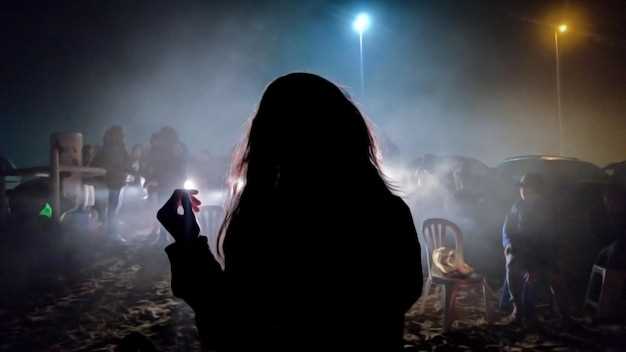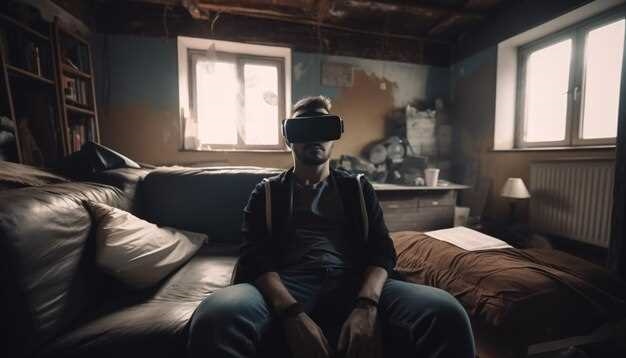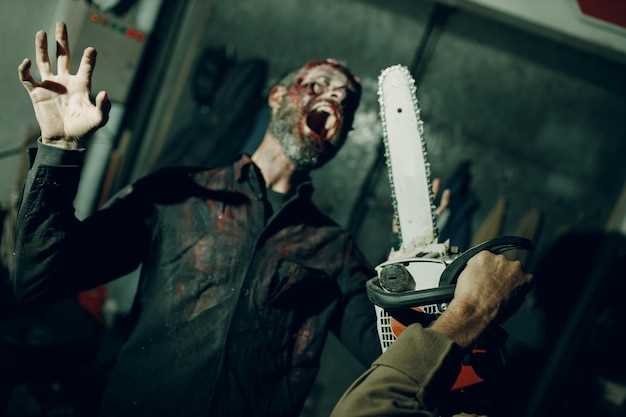
As darkness falls, there is an undeniable allure in surrendering oneself to the captivating realms of fear and terror. In today’s fast-paced world, where our senses constantly seek stimulation, the horror genre has always managed to intrigue and captivate audiences with its ability to evoke spine-chilling emotions that push the boundaries of human imagination.
Unsurprisingly, the landscape of horror movies has long been a breeding ground for innovative storytelling, exploring the deepest fears and anxieties that lie within us all. However, it is the constant evolution of the genre, shaped by emerging societal trends and the inherent changes in human psychology, that keeps audiences on the edge of their seats.
Experiencing horror through the lens of contemporary cinema offers a captivating glimpse into the fears and nightmares that haunt modern society. It serves as a fascinating reflection of our collective fears, addressing both the phantoms that linger in the confines of our own minds and the external forces that unsettle our fragile world.
Delving into the latest horror movie trends unveils a myriad of themes that resonate deeply with today’s audiences. From the exploration of technological terror to the chilling ramifications of scientific advancements, these films serve as cautionary tales that remind us of the fragility of humanity in an increasingly complex and interconnected world.
The power of horror lies not only in its ability to shock and scare, but also in its capacity to tackle profound social issues. By weaving together elements of suspense, gore, and psychological torment, these gripping narratives shed light on the darkest corners of society, exposing our primal fears and the haunting consequences of our actions.
The Rise of Psychological Horror: Examining the Popularity of Mind-Bending Thrillers
In today’s ever-evolving landscape of the film industry, there has been a noticeable surge in the popularity of mind-bending thrillers within the horror genre. This intriguing trend captures the attention of audiences by delving deep into the dark recesses of the human psyche, leaving them captivated and haunted long after the credits roll.
The Allure of the Mind-Bending Thriller
Unlike traditional horror movies that rely heavily on gore and jump scares, psychological horror films aim to target the viewers’ deepest fears by embarking on a disturbing journey through the twisted corridors of the human mind. By strategically leveraging elements such as suspense, uncertainty, and psychological manipulation, these movies create an atmosphere of intense fear and unease that resonates with viewers on a profound level.
The Impact of Psychological Horror
The increasing popularity of mind-bending thrillers can be attributed to their ability to challenge the audience’s perception of reality and provoke thought-provoking discussions long after the movie has ended. These films often confront existential questions, explore the nature of identity and sanity, and blur the line between what is real and what exists only in the dark corners of the subconscious mind. Through their gripping narratives and mind-bending twists, psychological horror films have become a platform for exploring the complexities of the human condition and the fears that lie dormant within us all.
Unconventional Monsters: How Modern Horror Films Are Redefining the Concept of Fear
In the realm of contemporary horror cinema, filmmakers have begun to veer away from conventional monsters and are, instead, presenting audiences with a new breed of terrifying creatures. By deviating from traditional horror tropes, these films are challenging our perceptions of fear and providing a fresh perspective on what truly scares us.
Redefining Monstrosity
Gone are the days of simplistic monsters with overtly supernatural attributes. Modern horror films are introducing a more nuanced and multidimensional approach to portraying fear-inducing beings. These unconventional monsters embody a reflection of our darkest, most primal fears, manifesting in forms that are as diverse as they are unsettling.
The Power of Symbolism
Underneath their outward appearances, these newly defined monsters often serve as powerful symbols or metaphors, taking on social, psychological, or cultural significance. They represent deeply rooted anxieties and issues plaguing society, giving horror films an unexpected depth and allowing audiences to confront and explore their own fears in a more contemplative manner.
From psychological tormentors to metaphorical embodiments of societal fears, these unconventional monsters are reshaping the horror genre. By reinventing what it means to be afraid, modern horror films are pushing boundaries and challenging audiences to confront their deepest fears in new and thought-provoking ways.
The Influence of Technology: Exploring the Role of Virtual Reality and AI in Contemporary Horror
In today’s ever-evolving technological landscape, the boundaries between reality and virtual experiences are becoming increasingly blurred. This article aims to delve into the intriguing relationship between technology and horror, specifically focusing on the captivating realms of virtual reality (VR) and artificial intelligence (AI), and their impact on contemporary horror narratives and audience experience. By examining the role of VR and AI in shaping the horror genre, we can gain a deeper understanding of how these advancements are effectively scaring and captivating audiences today.
Virtual Reality:
Virtual reality, or VR, has revolutionized the way we consume and engage with entertainment. With VR headsets transporting users into immersive and interactive virtual worlds, horror filmmakers have seized the opportunity to push the boundaries of fear. Through the use of realistic graphics, 360-degree perspectives, and binaural audio, VR horror experiences aim to plunge audiences into nightmarish scenarios, evoking a heightened sense of dread and terror. This section explores how VR has redefined the concept of “jump scares,” creating a more personal and visceral horror experience that leaves audiences deeply unsettled long after the VR headset is removed.
Artificial Intelligence:
In recent years, artificial intelligence, or AI, has become a driving force in various industries, and the horror genre is no exception. From intelligent antagonists to dynamic storytelling, AI is shaping the future of horror narratives. By utilizing AI algorithms, horror films can adapt and tailor their scares based on audience reactions and individual preferences. This section investigates the role of AI in crafting personalized horror experiences, examining how it enhances suspense and tension by predicting audience fears and tailoring the plot and scares accordingly. Additionally, we explore the ethical implications surrounding the use of AI in horror storytelling, raising questions about consent, manipulation, and the potential for psychological harm.
In conclusion, the integration of virtual reality and artificial intelligence in contemporary horror movies has opened new avenues for filmmakers to terrify and captivate audiences. The immersive nature of VR and the adaptability of AI allow for a more personalized and intense horror experience, pushing the boundaries of fear and challenging traditional storytelling techniques. As technology continues to advance, it will be fascinating to witness how these mediums evolve and shape the future of horror cinema.
From Found Footage to Cinematic Universes: Innovations Driving the Evolution of Horror
Exploring the ever-evolving landscape of horror films, this section delves into the innovations that have shaped the genre and captured the imaginations of audiences. From the pioneering use of found footage to the creation of expansive cinematic universes, horror movies have continuously pushed boundaries and embraced new techniques to terrify and thrill viewers.
1. Found Footage: Revolutionizing Fear
One of the most significant innovations in horror cinema has been the emergence of found footage films. This subgenre presents the story through the lens of a character’s camera, giving viewers a firsthand and immersive experience. Through shaky camerawork, authentic dialogue, and realistic visuals, found footage movies create a sense of dread and suspense that resonates with modern audiences. From “The Blair Witch Project” to “Paranormal Activity,” these films have redefined the way horror stories are told and have become a staple of the genre.
2. Cinematic Universes: Expanding the Horror Experience
Moving beyond standalone films, horror has embraced the concept of cinematic universes, much like their counterparts in the superhero genre. By interconnecting stories and characters across multiple movies, horror franchises have tapped into audience engagement and created a sense of continuity that keeps viewers captivated. Examples include the “Conjuring Universe” and the “Halloween” series. These cinematic universes not only provide a rich tapestry of interconnected narratives but also allow for the exploration of additional terrifying elements, expanding the horror experience beyond individual films.
- Shared Characters: Cinematic universes within the horror genre often introduce shared characters who appear in various movies. This approach creates a sense of familiarity and anticipation for fans, as they witness familiar faces navigating different terrifying scenarios.
- Expanded Mythology: Cinema universes provide filmmakers the opportunity to delve deeper into the mythology and lore established within the horror universe. This exploration adds depth and complexity to the overall storyline, while also building excitement and anticipation for future installments.
- Cross-Genre Collaborations: Cinematic universes can also bring together different subgenres of horror, creating unique and unexpected crossovers. Such collaborations allow filmmakers to experiment with various thematic elements and push the boundaries of conventional horror, offering audiences a fresh and thrilling experience.
In conclusion, the horror genre continues to evolve through innovative techniques and concepts. Found footage films offer a unique perspective, immersing audiences in the terrifying events, while cinematic universes provide a broader and interconnected world for fans to explore. As the genre continues to evolve, filmmakers will undoubtedly push the boundaries further, ensuring that horror remains a captivating and fear-inducing genre for audiences today and in the future.
Social Commentary and Political Subtext in Horror Movies: Why Fear Is More Than Just Entertainment
Within the realm of contemporary horror cinema, an emergent trend has surfaced: the incorporation of social commentary and political subtext. Horror movies are no longer mere sources of entertainment or passive scare-fests; they have evolved to become nuanced reflections of society, exploring deeper fears and anxieties that resonate with audiences today. Through careful examination and analysis, we can uncover the underlying messages and critiques that these films convey, shedding light on the broader social and political issues that shape our world.
Unearthing Layers of Symbolism and Metaphor
Horror movies have long been known for their ability to tap into our primal fears. However, recent films have taken this a step further by employing symbolism and metaphor to address pressing societal concerns. From supernatural creatures representing our collective fears of otherness to haunted houses that serve as allegories for the dark secrets and traumas of our past, horror movies are using fear as a means of exploring and commenting on issues like racism, gender inequality, and class divisions.
By delving into the intricate layers of these films, we can decipher the subtext and find connections to real-world events and phenomena. For instance, the rise of supernatural horror films that depict demonic possession or ghostly encounters can be seen as a reflection of our increasing fascination with the occult, religious beliefs, and the lingering presence of traumatic histories. Similarly, the prevalence of zombie apocalypse narratives can be interpreted as a reflection of anxieties surrounding societal breakdown, pandemics, and the loss of individual agency.
A Broader Allegory: Horror as a Critique of Power Structures
The horror genre also serves as a powerful tool for critiquing power structures and societal norms. Through the portrayal of monstrous figures and chaotic worlds, horror movies challenge established authority, interrogate social hierarchies, and expose the flaws and injustices that lurk beneath the surface. By casting a lens on the darker aspects of our world, these films provide a platform for dialogue and reflection on issues such as corruption, abuse of power, and the consequences of unchecked authority.
Furthermore, horror movies often disrupt traditional gender roles and challenge heteronormative narratives. They subvert expectations, presenting complex and multi-dimensional female characters as heroes or victims who defy societal expectations and fight against oppressive forces. By doing so, horror movies empower marginalized voices, highlighting the struggles and triumphs of individuals who are often overlooked or dismissed.
| Key Points |
|---|
| Horror movies are incorporating social commentary and political subtext to address societal concerns. |
| Symbolism and metaphor in horror movies allow for the exploration of broader social issues like racism, gender inequality, and class divisions. |
| The horror genre critiques power structures, exposing flaws, and injustices in society. |
| Horror movies subvert traditional gender roles and challenge heteronormative narratives. |
Exploring Cultural Horror: Analyzing the Global Influences on Contemporary Scary Films
Delving into the realm of cultural horror, this section seeks to dissect the underlying influences from diverse societies that have shaped the landscape of modern horror films. Examining how global cultures contribute to the creation of contemporary scary movies provides an intriguing insight into the fears and anxieties shared by audiences worldwide.
Unveiling Cultural Constructs: The Power of Folklore and Mythology
One significant aspect of cultural horror lies in its incorporation of ancient folklore and mythology. Through these cultural constructs, filmmakers not only tap into traditional beliefs and legends, but also harness the universal emotions, fears, and taboos embedded within these stories. By blending such narratives with modern horror elements, filmmakers create a fusion that resonates with audiences, transcending cultural boundaries and evoking collective fears.
Exploring Territorial Horrors: Unearthing Location-Specific Nightmares
Another intriguing dimension of cultural horror lies in the exploration of specific geographic locations as sources of fear. Different regions have their unique histories, natural phenomena, and urban legends, which serve as rich fodder for terrifying cinematic narratives. By delving into these location-specific nightmares, filmmakers not only generate intense suspense and terror but also offer viewers a glimpse into the anxieties and dark undercurrents of different societies.
These two aspects, folklore and location-specific horrors, are just the tip of the iceberg when it comes to the global influences on contemporary scary films. By analyzing these cultural nuances, we can gain a deeper understanding of how horror movies reflect the collective consciousness of societies around the world. So buckle up, for a bone-chilling journey awaits as we navigate the twists and turns of cultural horror in contemporary cinema.


